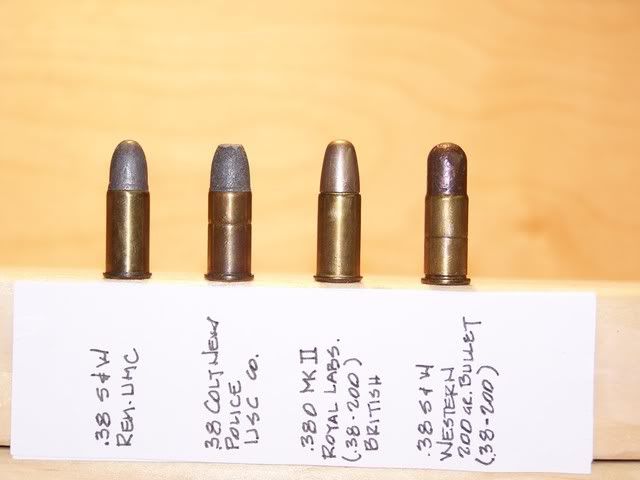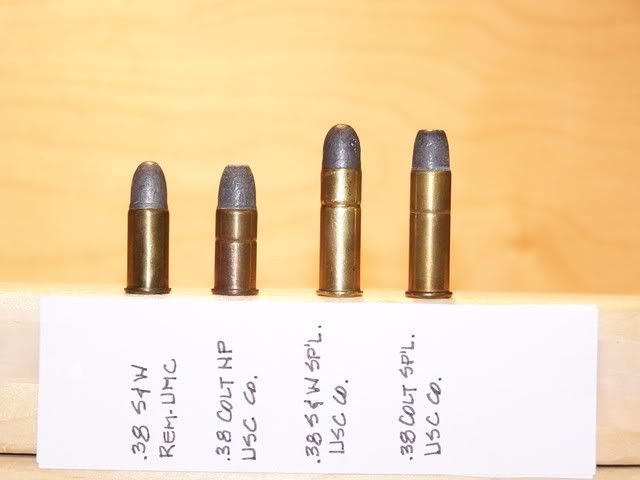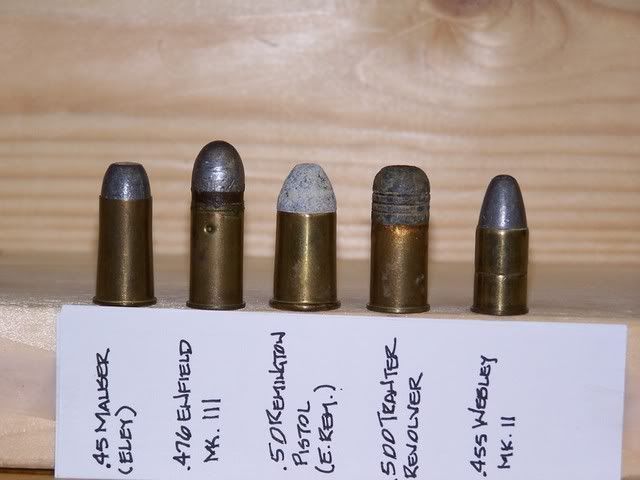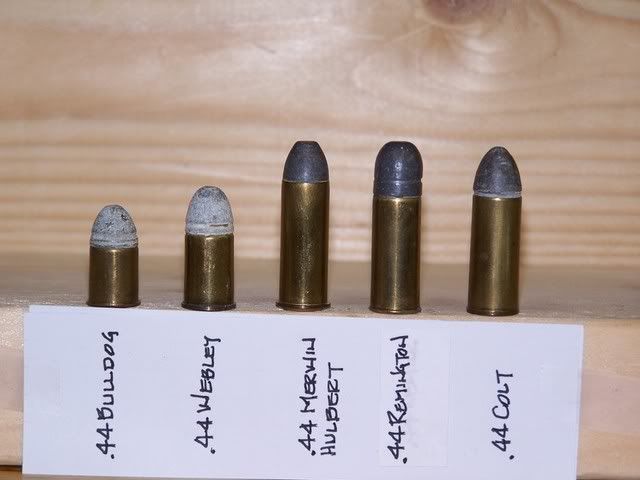
 |
|
|||||||
| Forum Rules | Firearms Safety | Firearms Photos | Links | Library | Lost Password | Email Changes |
| Register | FAQ | Calendar | Today's Posts | Search |
 |
|
|
Thread Tools | Search this Thread |
|
|
#51 |
|
Senior Member
Join Date: September 26, 2005
Location: Northern Virginia
Posts: 6,141
|
I forgot: there was also the .41 Long Colt, too, and presumably the .41 Short, not to mention the .41 rimfire as used in the Remington double derringer. Many have mentioned that a lot of the older cartridges disappeared by the time WWII was over and with the ammunition gone, the older guns because more or less useless for actual shooting. Skelton mentions converting .41 Colt Single Actions to another chambering with a new barrel and cylinder.
__________________
Shoot low, sheriff. They're riding Shetlands! Underneath the starry flag, civilize 'em with a Krag, and return us to our own beloved homes! Buy War Bonds. |
|
|
|
|
#52 |
|
Member In Memoriam
Join Date: March 17, 1999
Posts: 24,383
|
Hi, Bob, I was thinking of the Model 1906 revolver round, which would have been the one S&W was interested in. I would guess it was made short enough (shorter than the .45 Government/Schofield) to fit any reasonable length cylinder. I would like to know more about those tests and the selection, but I can't find any real info on that period, and not much on the M1909 revolver itself.
Some folks say it was never adopted at all, just some purchased until the M1911 was ready, but that seems contradicted by the formal adoption, assignment of a model number, development and production of special ammunition, adoption of a holster, etc. IMHO, the folks who adopted the M1909 assumed it would be in for the long haul, since no one at that time knew when, or even if, a satisfactory pistol would be found. The way that seemingly interminable testing was going, the new auto pistol might be the Model of 2011. Jim |
|
|
|
|
#53 |
|
Senior Member
Join Date: July 10, 2012
Location: Memphis, Tennessee
Posts: 2,989
|
Jim,
I can't find much on the M1906 rounds. Both the revolver and auto pistol rounds were pretty much similar, except for the rim for the revolver and extractor cannelure for the rimless cartridge. Both had 234 gr. jacketed bullets, and length of approximately .911" case length. Suydam alludes to the fact some Colt revolvers were made for the revolver and tried in the Phillippines. Also Colt, Smith & Wesson and Webley-Fosberry revolvers are known to exist. As to the M1909 round, I have one specimen dated Dec. 1913 (h/s F A 12 13) and understand it was loaded until 1915, so the Colts must have been in use up until about that time. Incidentally I have a government contract (REM-UMC) .38 Long Colt dated 1918, others from Frankford Arsenal dated 1911. Bob Wright Bob Wright |
|
|
|
|
#54 |
|
Member In Memoriam
Join Date: March 17, 1999
Posts: 24,383
|
The History of Modern U.S. Military Small Arms Ammunition (an accurate title but a mouthful) says the last production order to Frankford for M1909 cartridges, never made anywhere else, was for two million rounds* dated April, 1915, but that it might it not have been completed and that no specimen has been seen dated later than 12 13**. I have seen reports that M1909 revolvers were used in WWI for guard duty in the U.S. There have been claims that they were also sent overseas, but I think that unlikely because of the ammunition problem. There is also possibility of confusion with the Colt M1917, which is the same basic gun as the M1909, the Colt New Service.
Of course the M1909 could have been issued and used with .45 Colt commercial ammunition for stateside duty; the potential extraction problem would be less important than the need to get guns to those who might need them. As to .38 Long Colt, the book says this: "In late 1917, production of .45 caliber pistols was insufficient... and the Cal .38 revolver and cartridge were forced into service ... restricted to National Guard use in the U.S. and to rear areas overseas." Ammunition "contracts were let to two firms, Winchester (1,030,000 rounds) and Remington (8,950,000 rounds)." The Winchester contract was cancelled without deliveries, but Remington completed their share. Those rounds are marked REM-UMC 18; some have the "U" on the primer. The load was a 148 grain lead RN bullet ahead of 3 grains of Bullseye, giving a MV of 755 fps at 15,000 psi. Since that is in the target wadcutter range, apparently they didn't want to shoot anybody very hard. * A small order for Frankford. Just FWIW, their WWII production of .30 caliber ammunition, from late 1941 to early 1945 was 1.1 million rounds - per day. ** Neat coincidence, I have a specimen dated 12 13 also. Jim |
|
|
|
|
#55 |
|
Senior Member
Join Date: July 26, 2012
Location: Central Florida
Posts: 399
|
This doesn't qualify as braggin' rights, since it wasn't me, but my daddy was the commanding officer of Frankford Arsenal at the end of WWII. Had one cool-ass house, from what I was told - there was a button under the carpet at my mom's end of the dining room table that she would press to ring a bell in the kitchen. Surely that must qualify me as a gen-yoo-wine old fart. Which is all I claim to be, other than a decent shot.
|
|
|
|
|
#56 |
|
Senior Member
Join Date: September 26, 2005
Location: Northern Virginia
Posts: 6,141
|
I think it is reasonable to believe some of the older .38 army revolvers may have been sent overseas, if it was thought they could be spared. The British manufactured a huge variety of ammunition, including most contemporary American cartridges. In fact, up into the 1950s reference books generally had a separate listing of English cartridges. One lists a .450 revolver but I'm not sure what it is. It also lists a .380 revolver as well as a .380 Long, which was a rifle cartridge. In any case, there probably wouldn't have been an ammunition problem. Colt .45 autos were even sold in Briitain, including some in .455 Webley Self-Loading.
To return to the original subject, can a .455 Webley revolver cartridge be used in a revolver chambered for .45 Colt?
__________________
Shoot low, sheriff. They're riding Shetlands! Underneath the starry flag, civilize 'em with a Krag, and return us to our own beloved homes! Buy War Bonds. |
|
|
|
|
#57 |
|
Senior Member
Join Date: September 26, 2005
Location: Northern Virginia
Posts: 6,141
|
I also meant to ask if there were (new) revolvers available on the civilian market after the .38 special came out? None are listed in the 1940 Shooter's Bible, although there are lots of models in .38 S&W. There were many Iver Johnsons listed as available also in .32 Special, whatever that is. However, the only .45 Colt revolvers were Colts, including the New Service, New Service Target, the Shooting Master and the Single Action Army. S&W didn't have one in that caliber, the closest one being the 1917 in .45 ACP.
__________________
Shoot low, sheriff. They're riding Shetlands! Underneath the starry flag, civilize 'em with a Krag, and return us to our own beloved homes! Buy War Bonds. |
|
|
|
|
#58 | |
|
Senior Member
Join Date: December 31, 2011
Location: Vermont
Posts: 2,076
|
Quote:
British designation for the war time cartridge was .380/200...AKA .38 S&W... |
|
|
|
|
|
#59 |
|
Senior Member
Join Date: September 26, 2005
Location: Northern Virginia
Posts: 6,141
|
That could be but they also listed separately the .38-200 or .380 Mk. 1 (for Mark IV Revolver). That's the actual listing. But they also list the .38 S&W as well as the .38 Colt Police Positive Revolver. That's just the cartridge listing.
It doesn't follow that any of these British cartridges were widely available anywhere in the United States, especially since American manufacturers would be making anything they could sell here. Moreover, this was from a 1940 catalog and it is doubtful if British factories were exporting much ammunition for civilian consumption. The British cut back on sporting ammuntion a lot after the war and all those white hunters in Africa using expensive British doubles had a time getting ammunition. That was around when the big bore Winchesters became popular.
__________________
Shoot low, sheriff. They're riding Shetlands! Underneath the starry flag, civilize 'em with a Krag, and return us to our own beloved homes! Buy War Bonds. |
|
|
|
|
#60 |
|
Staff
Join Date: April 13, 2000
Location: Northern Virginia
Posts: 41,390
|
The .380 round being talked about was probably the .380 revolver. It was an older british round and may have been a direct influence on the .38 Long.
It was loaded here for a number of years.
__________________
"The gift which I am sending you is called a dog, and is in fact the most precious and valuable possession of mankind" -Theodorus Gaza Baby Jesus cries when the fat redneck doesn't have military-grade firepower. |
|
|
|
|
#61 |
|
Senior Member
Join Date: December 31, 2011
Location: Vermont
Posts: 2,076
|
It's my understanding that the ".380 Revolver" started as the .380/200 (380 Mk I)...According to what I have read, the military loading changed in 1937 to the 178gr FNJ (380 Mk II), but the cartridge was still called the ".380 Revolver"...
http://www.bocn.co.uk/vbforum/thread...ot-38-200-quot As far as I can find, the only external difference between the Mk I, and Mk II, is a very slightly smaller diameter rim...Internally they had a different primer pocket/case capacity, and the lighter bullet...The internal differences would of course require different load data...But they would still chamber and fire in a .38 S&W, etc... Dunno...Interesting, nonetheless... |
|
|
|
|
#62 |
|
Staff
Join Date: April 13, 2000
Location: Northern Virginia
Posts: 41,390
|
Salmon,
I'm pretty sure the .380 Revolver being referred to is NOT the .380-200, which was a British take on the .38 Smith & Wesson/.38 Colt New Police. Webley developed a heeled-bullet design around 1868 for its revolvers, both short and long versions. It's listed on page 382 of the 11th edition of Cartridges of the World. The long version, at least, was loaded in the United States until after World War I. The .450 revolver cartridge that is listed in the books is probably the .450 Adams, which was adopted as the British military standard round in 1868 and served until the .476 Enfield (.455, actually) was adopted in 1880. While not a very successful military cartridge, the .450 was very popular commercially because it could be fit into a small, light gun. S&W and Colt both chambered revolvers for it for sale here in the US and in Europe. Can't remember for certain, but H&R may have also offered it for sale at one point in time in their revolvers. It was popular enough in the United States to be listed in most ammo catalogs until the companies began ramping up for World War II production.
__________________
"The gift which I am sending you is called a dog, and is in fact the most precious and valuable possession of mankind" -Theodorus Gaza Baby Jesus cries when the fat redneck doesn't have military-grade firepower. |
|
|
|
|
#63 |
|
Staff
Join Date: April 13, 2000
Location: Northern Virginia
Posts: 41,390
|
"It doesn't follow that any of these British cartridges were widely available anywhere in the United States"
Don't kid yourself. Webley revolvers sold fairly well in the United States before World War I. In addition, with Francis Bannerman snatching up surplus globally and selling it in the United States, these cartridges and revolvers, while probably not very common, were more than popular enough to support 40 or more years of cartridge production in this country. Check this out for a sectioned view and headstamp on a UMC-made .450 revolver cartridge. http://www.iaaforum.org/forum3/viewtopic.php?f=1&t=4058 And, lastly, remember who is to our North. The Canadians looked largely to the United Kingdom for their ideas on armaments, but they often looked to the United States for the ammunition for them.
__________________
"The gift which I am sending you is called a dog, and is in fact the most precious and valuable possession of mankind" -Theodorus Gaza Baby Jesus cries when the fat redneck doesn't have military-grade firepower. |
|
|
|
|
#64 | |
|
Senior Member
Join Date: September 8, 2007
Location: Mississippi
Posts: 16,190
|
Quote:
They were clips while I was growing up. It seemed to have changed almost overnight and computers has only made it worse. They're still clips to me and I say .45 Colt....Go figure. 
|
|
|
|
|
|
#65 | |
|
Senior Member
Join Date: December 31, 2011
Location: Vermont
Posts: 2,076
|
Quote:
The earliest reference I find to any Webley referred to as a .38 or .380, is the Mark iii 'Pocket' Which started in 1897...This is chambered in ".38 Revolver" which is our ".38 S&W"... I know it is off topic, but As I do not own that book, could I bother you for the dimensions of the case length, mouth and rim widths of the cartridge you are looking at?? |
|
|
|
|
|
#66 |
|
Senior Member
Join Date: September 26, 2005
Location: Northern Virginia
Posts: 6,141
|
All of those different cartridges were listed separately, although that doesn't necessarily make them all different. Those were just from the listing of English cartridges.
During the surplus gun boom of the late 1950s and early 1960s, Webleys (Weblies?) became relatively common. They could be purchased for as little as $15.00 but $15 went a little further 50 years ago. Elmer Keith even made reference to the .455 Webley. He considered it good but I wouldn't say he exactly thought highly of it. That listing of English cartridges I keep mentioning, by the way, lists pressures for most of the rifle cartridges in tons per square inch as well as the powder type and weight. Some were black powder loads.
__________________
Shoot low, sheriff. They're riding Shetlands! Underneath the starry flag, civilize 'em with a Krag, and return us to our own beloved homes! Buy War Bonds. |
|
|
|
|
#67 |
|
Staff
Join Date: April 13, 2000
Location: Northern Virginia
Posts: 41,390
|
Here's some more information on them:
http://www.ammo-one.com/380LongRifle.html Fiocchi still loads it for European consumption. There was a similar cartridge, the .320 revolver, from the same time frame. .380 Revolver dimensions are: Bullet - .375 Neck - .377 Base - .380 Rim - .426 Rim thickness - .046 Case Length - .70 Cartridge Length - 1.10 From some of the things I'm pulling up it appears that it was also a fairly popular cartridge for light single shot rifles, or Rook rifles, of the time.
__________________
"The gift which I am sending you is called a dog, and is in fact the most precious and valuable possession of mankind" -Theodorus Gaza Baby Jesus cries when the fat redneck doesn't have military-grade firepower. |
|
|
|
|
#68 |
|
Staff
Join Date: April 13, 2000
Location: Northern Virginia
Posts: 41,390
|
Surplus Webley military revolvers in .380-200 and .455 became very popular after World War II.
I'm talking about well before World War II. Webley began selling revolvers in the United States through agents sometime in the 1870s. The British Bulldog was popular enough here that the general pattern was copied by American manufacturers, including Iver Johnson. The .44 Webley, pretty much the standard large-caliber round for these pistols, even the American-made ones, was loaded in the United States up through World War II. This is an early box, but it's American, from about 1880 to 1900.  A lot of people seem to think that the entire history of revolvers in the United States is one of American designed, American made, and American used. Nothing could be farther from the truth. And wow, I just found this... Even neater, given that it's a box of blanks... 
__________________
"The gift which I am sending you is called a dog, and is in fact the most precious and valuable possession of mankind" -Theodorus Gaza Baby Jesus cries when the fat redneck doesn't have military-grade firepower. |
|
|
|
|
#69 |
|
Staff
Join Date: April 13, 2000
Location: Northern Virginia
Posts: 41,390
|
Oh, and something needs to be said about the .44 Bulldog cartridge...
 That was an American competitor to the .44 Webley. It used a shorter case of considerably less power (not that the .44 was a powerhouse in itself. Apparently, though, the .44 Bulldog would fit nicely in the .44 Webley cylinder, but the opposite wasn't always the case.
__________________
"The gift which I am sending you is called a dog, and is in fact the most precious and valuable possession of mankind" -Theodorus Gaza Baby Jesus cries when the fat redneck doesn't have military-grade firepower. |
|
|
|
|
#70 |
|
Staff
Join Date: April 13, 2000
Location: Northern Virginia
Posts: 41,390
|
And, as you can see from this image, UMC manufactured the .45 Webley cartridge. In Britain it was the military .450 Adams cartridge, adopted in 1860.
Webley was the main seller in the United States of guns in this caliber, so it became known here as the .45 Webley. And no, it is definitely NOT the .455 Mk I or Mk II. Those rounds had cases that were significantly longer. I know that Winchester also loaded .45 Webley. 
__________________
"The gift which I am sending you is called a dog, and is in fact the most precious and valuable possession of mankind" -Theodorus Gaza Baby Jesus cries when the fat redneck doesn't have military-grade firepower. |
|
|
|
|
#71 |
|
Senior Member
Join Date: September 26, 2005
Location: Northern Virginia
Posts: 6,141
|
Interesting. Note that the box of the Winchester .44 Webley says "solid head."
__________________
Shoot low, sheriff. They're riding Shetlands! Underneath the starry flag, civilize 'em with a Krag, and return us to our own beloved homes! Buy War Bonds. |
|
|
|
|
#72 |
|
Senior Member
Join Date: July 10, 2012
Location: Memphis, Tennessee
Posts: 2,989
|
At the risk of monopolizing this discussion to the point of being obnoxious, here are some .38 S&W/Colt NP/.380 Revovler:
 And, just for grins:  And more:  And, just for bunkum:  Sorry if I'm getting laborous. Bob Wright |
|
|
|
|
#73 | |
|
Senior Member
Join Date: July 10, 2012
Location: Memphis, Tennessee
Posts: 2,989
|
Quote:
Bob Wright |
|
|
|
|
|
#74 |
|
Staff
Join Date: April 13, 2000
Location: Northern Virginia
Posts: 41,390
|
"Not quite what you might think. Many British cartridges used a battery cup primer (Think 12ga. shotgun shell) with the battery cup serving as a rivet to hold the rim in place. The rim was a separate diac from the case."
Uhm... That wasn't really used in handgun cartridges, was it? As far as I know, that was primarily done with the wound foil and paper cases (.577 Snider, .577-.450) in the early days before they figured out how to properly draw brass cases. In the case of the .577 the "rim" was actually a flat iron washer. Normally there was a small brass cup at the case head that would support where the foil/paper attached to the head. This .577-.450 shows that kind of case construction I have never, however, heard of that type of construction being applied to handgun cartridges in the United States nor have I ever heard of the term "solid head" being used to denote a on-piece case as opposed to the built-up composite case.
__________________
"The gift which I am sending you is called a dog, and is in fact the most precious and valuable possession of mankind" -Theodorus Gaza Baby Jesus cries when the fat redneck doesn't have military-grade firepower. |
|
|
|
|
#75 |
|
Senior Member
Join Date: December 31, 2011
Location: Vermont
Posts: 2,076
|
My thanks to all, and apologies for the thread drift
After an hour of searching, here is the only reference I can find to an earlier ".38 or.380 Revolver" cartridge:
The ".380 Revolver" round had been developed in the middle 19th Century for use in small concealable revolvers. It's a pretty anemic round (a 124 grain bullet at 625 fps, for a whopping muzzle energy of 110 foot-pounds) similar to the .38 Short Colt. In 1887 Smith & Wesson had developed the .38 S&W round for its line of top-break revolvers. Boasting a heavier bullet (160 grains) and more energy (250 f-p at the muzzle), it was better but still no world-shaker. Starting from these two datum points, the Webley firm, with an eye on the new requirements, developed a new round in the early 1920's for British Army trials. It fired a 200-grain lead bullet propelled by "Neonite" powder at a muzzle velocity sufficient to give it reasonable power. It comes from this page during a discussion of the history of the Webley: http://www.nrvoutdoors.com/ENFIELD%2...ELD%20SNUB.htm I find only that single reference for pre-1897, yet literally hundreds after that date that refer to the military loading of the .38 S&W as the '.380 Revolver'... I find it hard to believe that the reloading manual that BlueTrain mentions from 1940ish is referring to a healed bullet obsolete cartridge from 1867, but I guess anything is possible... |
|
|
 |
|
|